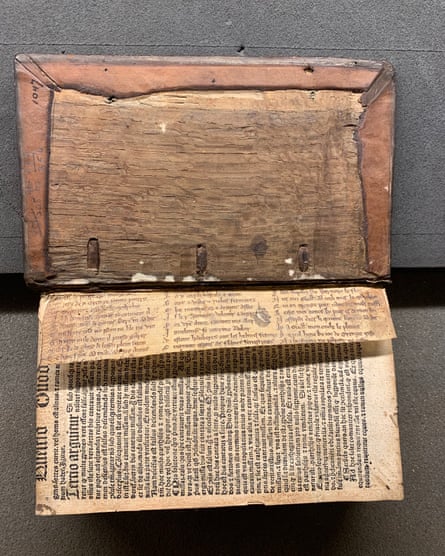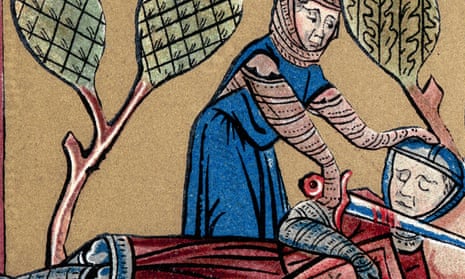A fragment from a 12th-century French poem previously believed to have been lost forever has been found by an academic in Oxford’s Bodleian Library.
Dr Tamara Atkin from Queen Mary University of London was researching the reuse of books during the 16th century when she came across the fragment from the hitherto lost Siège d’Orange in the binding of a book published in 1528. Parchment and paper were expensive at the time, and unwanted manuscripts and books were frequently recycled.
Scholars had believed the poem, which comes from a cycle of chansons de geste – epic narrative poems – about Guillaume d’Orange, existed, but there had previously been no physical evidence that this was true. The fragment only runs to 47 lines, but it proves the existence of a poem thought to have been completely lost.
The poem is set in the ninth century, during the reign of Louis the Pious, Charlemagne’s son and heir. Atkin said that while it is believed to have been composed in the late 12th century, the fragment itself is from a copy made in England in the late 13th century.

“Il li demande coment se contient il? / Mauuoisement li quiens Bertram ad dit / Tun frere n’ad ne pain ne ble ne vin / Garison nule dont il puisse garir / Mais ke de sang li lessai plein Bacin,” runs an early section of the fragment, which Philip Bennett, an expert on Guillaume d’Orange from the University of Edinburgh, has translated as: “He asks him, ‘How goes it with him?’ / ‘Badly,’ said Count Bertram. / ‘Your brother has neither bread nor corn nor wine; / He has no supplies with which to save himself, / Except for one basinful of blood, which I left him.’”
The quoted lines come as Bertram begs the king for help relieving the siege of Orange, a city in the Rhône Valley, describing the dire siege conditions. “In later parts of the fragment we hear him berating the queen (at one point he even calls her ‘pute russe’ or ‘red-headed whore’), who has objected to her husband leading a relieving army south,” said Atkin.
Atkin also found a parchment fragment from Béroul’s Roman de Tristan, telling part of the story of Tristan and Iseult, in the same book. The 12th-century poem is one of the earliest versions of the medieval romance, and until now the only evidence of its existence had been an incomplete 13th-century manuscript in the Bibliothèque Nationale de France. The fragment found by Atkin differs “significantly” from the manuscript, and shows the poem was circulated more widely than had previously been thought.
“When you find manuscript waste in a 16th-century book, it tends to be in Latin, and it’s almost always something theological or philosophical, and from the point of view of modern-day literary scholarship, perhaps not that interesting. But the fragments in this book were different,” said Atkin. “They were in French, they were in verse, and in one of the fragments the name Iseult immediately jumped out. I’m not a French scholar, and I realised I was going to need to bring in some collaborators. From there, it’s just been really fun and exciting.”
She approached academics from the universities of Bristol, Edinburgh and British Columbia to help. “I knew it was something important,” said JR Mattison, a French-manuscript specialist from the University of British Columbia who helped to identify the Tristan and Iseult fragment. “This piece of the poem comes from a significant moment when Iseult speaks with her husband King Mark. This fragment expands our knowledge of the poem’s audiences and its changing meaning over time and contributes a new perspective on how Tristan legends moved across Europe.”
Bennett said there had been “no physical trace” of the Siège d’Orange poem before. “There is much evidence from other chansons de geste that a poem about the siege Guillaume d’Orange suffered in his newly conquered city must have once existed,” he said. “The discovery of the fragment we now have fills an important gap in the poetic biography of the epic hero. This is a most exciting addition to the corpus of medieval French epic poetry.”
The team will now work to discover more about when and where the fragments were copied, and how they came to be bound in the 1528 book. “That manuscripts were made at all reflects the value once placed on the texts they contain. But manuscripts that were dismembered and reused as waste were no longer valued as texts. Their only value was as a material commodity – parchment – that could be used to reinforce the binding of another book. The manuscripts containing these French poems were probably recycled because the texts were considered old-fashioned and the language outdated,” said Atkin.
“It’s fantastically exciting to discover something that’s been lost all this time, but I do think it is also worth simultaneously holding the thought that actually, the only reason these fragments have survived is because at some point, someone thought the manuscripts in which they appeared were not valuable as anything other than waste. There’s a sort of lovely tension in that, I think.”
